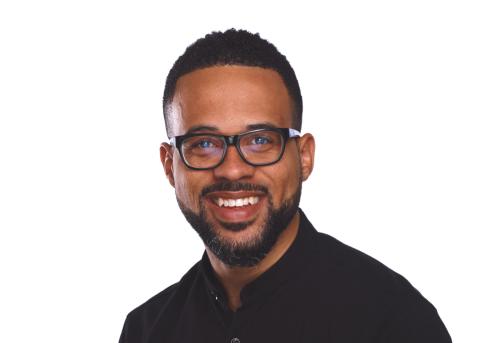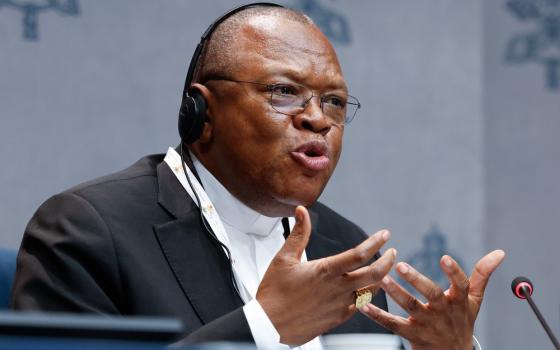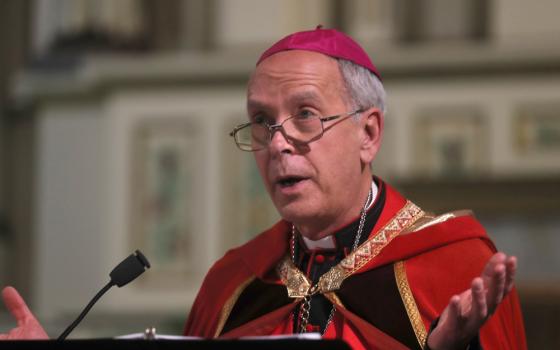
Pastor Michael Martin of Stillmeadow Community Fellowship Church addresses volunteers after the May 2018 flood in Baltimore’s Beechfield neighborhood. (Photo courtesy Miracle City Church)
On the morning of Memorial Day 2018, it took Michael Martin an hour to drive less than a mile to get to his church, Stillmeadow Community Fellowship in southwest Baltimore's Beechfield neighborhood. He was forced to navigate the neighborhood's battered back streets and alleyways, ruining three of his car's tires in the process. To Martin, who had recently moved to Baltimore from southern California, the torn-up roads, with ten-foot slabs of displaced asphalt, looked like the aftermath of a major earthquake.
Severe storms from the previous day had caused a massive flash flood along the neighborhood's main road, Frederick Avenue, where Martin's church is located. The flooding was so intense on Sunday that the Baltimore Fire Department deployed boats into seven feet of water to rescue more than 20 people from car rooftops and a stranded bus, according to the Baltimore Sun.
Because of its placement atop a hill overlooking the street, Stillmeadow escaped the Frederick Avenue flood relatively untouched. By the time Martin arrived, nearby residents had already begun to gather in the church parking lot, processing the previous day's traumatic event.
He wasn't expecting this. At age 61, Martin had already served as a pastor for 24 years when he left Los Angeles in 2017 to lead Stillmeadow. His expertise – ranging from human resources work to music composition – did not include disaster response.
"I didn't know what I was supposed to do," Martin told NCR of his initial reaction. "But I'm the pastor in the area, so I'm supposed to do something."
Although initially feeling unprepared, Martin and pastors from two other nearby churches soon took on critically important leadership roles in managing the crisis. The physical space and volunteer services the three churches provided, along with serving as an intermediary between emergency resources and the community, proved crucial to the immediate and longer-term recovery of Beechfield.
Climate change
"We have to prepare for the mental impacts of climate change," Martin said. "We've got to prepare for these types of emergencies, to not just secure and minimize loss of life but actual recovery. We have to budget for it, we have to train for it. And we need the state government to come around to denominations of churches and say this is how we need you to partner with us, because it's going to keep getting wet."
While aging infrastructure and Beechfield's location on a floodplain both contributed to the degree of flooding, the dramatic Memorial Day weekend event fits a climate pattern that suggests more rainfall and severe storms to come.
This wasn't the first flood of its kind in the area. Two years earlier, in 2016, a similar flood rolled through Frederick Avenue. And just two months after the Memorial Day weekend storm, in July 2018, another slightly less significant flood hit the neighborhood, further prolonging recovery efforts and affecting families.
"It was surreal in a lot of ways to have two 'hundred year storms' back-to-back in an area that has had flooding in the past but not in that way," Baltimore City Council member Kristerfer Burnett told NCR.
Advertisement
According to the Center for Climate and Energy Solutions, extreme precipitation events, like the Beechfield floods, have produced more rainfall and become more common since the 1950s. This trend is expected to continue, according to the National Climate Assessment, which found a 71 percent increase in the amount of precipitation falling in very heavy precipitation events in the northeast.
In nearby Ellicott City, Maryland, which was hit by the same storm, NBC News reported May 27, 2018, that the area was hit with six inches of rain in just two hours. Later that year, the Baltimore Sun reported that 2018 was Baltimore's wettest year on record, "by far," with 8.17 inches of rain falling in May alone.
Immediate response
Pastor David Franklin of nearby Miracle City Church arrived at Stillmeadow on Memorial Day morning shortly after Martin. Franklin, 37, has served as Miracle City's pastor since 2015. He had been driving home from out of town when he first learned about the flood.
As the pastors talked with residents, they learned about many of what Franklin described as the community's "harrowing experiences" – cars falling off the side of the road, folks being pulled out of the stranded bus. The two men worked with other community members to try to address any immediate needs they could – cleaning out homes, getting doors shut and providing laundry cards to get clothes cleaned. Since it was Memorial Day, Martin even went to the local grocery store and brought back food for a cookout.
The pastors' informal assistance soon turned to more formal community leadership, filling in the gaps where city government assistance was limited.
"The churches played a critical role. I don't think we could have done it without them," Burnett said, who described Beechfield as a diverse community that has a lot of older residents and working families.
Stillmeadow became what the pastors called "ground zero" for emergency management. City-sanctioned emergency services set up stations inside the church building, a space easily accessible to Beechfield residents. "It looked like a fair," Martin said.

Pastor David Franklin (provided photo)
In the days after the flood, volunteers from Stillmeadow, Miracle City and the Broken Wall Project – the third local church involved in recovery efforts – collaborated with Baltimore's office of emergency management and local neighborhood associations to assess the damage in the neighborhood. Volunteers went through the neighborhood door-to-door and entered the findings into a comprehensive database provided by the National Voluntary Organizations Active in Disaster. According to the pastors, the coalition eventually learned that more than 200 homes were damaged by the flood.
"Early on a lot of the work was coordinating all of those teams and making sure residents had the opportunity to get real time information and then advocate for their needs," Franklin said.
Despite the number of organizations present to help, Franklin said it was still a challenge for residents to understand what resources were available to them and what organizations in the city more broadly could support them in the cleanup process.
"Myself, Pastor Martin, and Pastor [Ron] Willoughby from Broken Wall, all came together to be the advocator, go-between, liaison between the residents and the city," Franklin said. The pastors said this liaison work included such tasks as requesting dumpsters or alerting the city to homes that needed water pumped out.
Feeling drafted
After the initial clean-up phase in the days after the flood, attention shifted to removing mold from people's homes and setting up residents for sustainable long-term recovery.
According to Martin, the churches worked with the National Voluntary Organizations Active in Disaster to facilitate a long-term plan for recovery.
To address the mold in people's homes, Broken Wall requested the help of Team Rubicon, a national service organization that mobilizes veterans to respond to disasters. Stillmeadow provided Team Rubicon's volunteers with food and lodging while they worked on nearby homes over the next few weeks.
Franklin's church, Miracle City, raised $155,000 through individual and organizational donations to pay subcontractors to clean out homes, as well as purchase new furnaces and additional equipment to mitigate home damage in future floods.
Over the course of the next 12 months following the flood, Miracle City also deployed more than 100 volunteers to repair and paint damaged homes. Franklin said that he only learned toward the end of that project that some families still went through the winter without a furnace to heat their homes.
Martin said he felt out of his element in coordinating recovery efforts and personally became frustrated with what he saw as a lack of official structure for the long-term recovery of this community. He described feeling "drafted" into taking on this new leadership role with the other pastors.
"I think cities are most vulnerable [to climate change] and I think the poor aspects of city are the most most vulnerable, and I think we proved that," Martin said.

Debris collected in a dumpster after the flood. (Photo courtesy Miracle City Church)
With that understanding, the churches have led the community in a series of on-going community meetings, advocating for a more solid recovery plan should another disastrous flood take place.
No formal recovery plan has been adopted yet. Burnett said the city has taken some formal measures to address the communities' concerns, however. Those include adopting a new city-wide emergency alert system, designating Stillmeadow as an official "resilience hub" in any future emergencies, and applying to the Federal Emergency Management Agency for funds to address important infrastructure problems in Beechfield.
Still, despite the pastors' best efforts, the floods have had a draining effect on the community, leaving some residents looking for a way out.
"It was a lot, and what we're seeing now on the back-end is there are a lot of for sale signs on that block that weren't there before," Burnett said. "I think people are looking for a way out which is unfortunate because it destabilizes an otherwise strong neighborhood."
In the lead up to Memorial Day weekend 2019, Martin said the community did not anticipate the unofficial start of summer with typical excitement. Instead, the holiday weekend was met with anxious prayers.
"I don't know if we can respond again," Martin said. "The 'hundred year flood' that happened once and then again two years later – it has to skip this year, Lord, because I don't know what we could do. We're still slammed from recovering."
[Jesse Remedios is a Bertelsen editorial intern with the National Catholic Reporter.]






